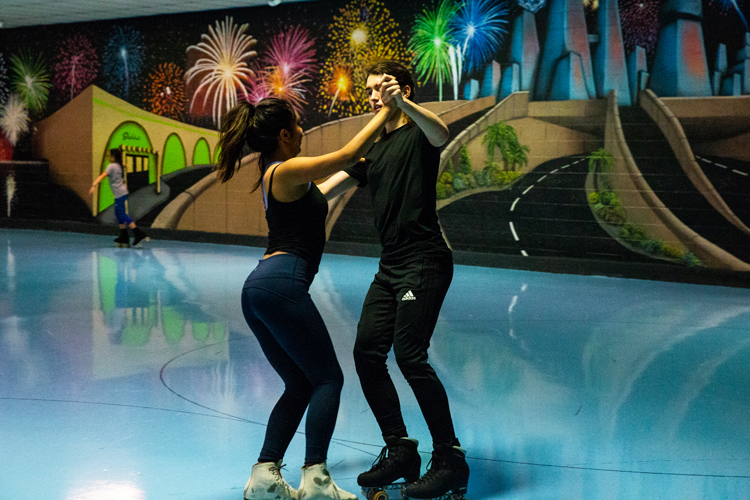The whirl of wheels, interspersed with sharp commands and bursts of laughter, punctuate Sunday practice for roller figure skaters in the Valley.
Before they step out to perform, the 12 members of the Phoenix Roller Sports Club sit down to lace their roller skates under a disco ball suspended from the ceiling and the glow of hot-pink lights that speckle the rink’s gray floors. Most of them had come into the Skateland rink blinking from the bright sun outside, dragging bulky sports bags through double doors illuminated by fluorescent bars overhead. Nearby, Skee-Ball machines sit in the darkness, awaiting quarters.
The roller figure skaters are not into roller derby, the competitive and well-known contact sport. These are figure skaters, similar to those we see gliding on ice – except they do it on concrete and on wheels.
Roller figure skating is a sport that many have never heard of, at least not in the United States, even though it’s where Tara Lipinski, the famous Winter Olympics gold medalist, got her start. Before she began her figure skating career on ice, Lipinski was a national competitive roller skater, winning a primary United States Roller Skating Championship freestyle event at age 9.
Unlike ice skating, there are no big crowds watching the roller figure skaters practice their routines, no television crews broadcasting their competitions to a national audience. This is mostly a close friends-and-family affair.
Club member Brock Turner, 16, said only a handful of his friends know of his skating – but they often confuse it with ice-skating until he sets them straight.
“They just say, ‘Oh, so cool! Never heard of it,’” Turner said with a self-deprecating laugh.
Still, Turner and his fellow skaters persevere. On this Sunday, they begin warming up by weaving through faded orange plastic cones that have been neatly aligned by a parent volunteer, one of several roller figure skaters who show up at practice. They’re usually the only spectators in the stands.
Dedication needed
From 8 a.m. to noon on Sunday, members of the Phoenix Roller Sports Club practice speed-skating, figures, dance and freestyle under the watchful eye of their coach, Polly Parks.
Sometimes, Parks stands to the side, watches and offers occasional comments: “Work on your form!” “Slower on your figures.” Other times, she demonstrates for the skaters, her brown hair tied back in a limp ponytail, her arms up and out, her movements carefully executed. More than once, she sweeps Turner off to the side, puts his hands on her hips, and skates in front of his partner, Emily Nguyen, also 16.
Roller figure skating is serious business to Parks and her team, but it’s clear that the Phoenix Roller Sports Club plays second fiddle at this rink in Mesa. As a rink employee walks by the yellow benches encircling the rink, her arms laden with gauzy-yellow paper tablecloths, Parks directs the team to move their things out of the way.
The skaters obey. They place their backpacks and spare skates against a wall as the employee wipes down tables and arrange decorations for a birthday party that will soon start.
Their practices, especially their extensive Sunday ones, are sometimes cut two hours short because other events at the rink take precedence.
That’s different from some European countries, Parks said, while her skaters crowded around a tablet watching the live-stream of a national championship event in France.
“They have government rec centers with skating,” she said. “They sell out stadiums in France, Spain, and Italy for competitions.”
In the United States, Parks said, “rinks are now amusement centers rather than sports facilities,” adding that there are now half as many rinks in the country than there were in the 1970s. Many have made way for malls and freeways.
It wasn’t always this way.
A different time
Karen Shumway, 68, a member of the Phoenix Roller Sports Club, remembers the sport being much more popular in her youth, back when roller rinks had wooden floors. Modern rinks are paved with treated concrete, which is slipperier and doesn’t provide as much traction as wood does.
Over time, as participation in roller figure skating dropped, the number and types of events began to change. In Shumway’s day, there was no solo dance event – only pair dance events. She believes that the male skaters drifted away in pursuit of more “macho” sports, such as football.
“We girls were left without partners,” she said, chuckling. Even boys that compete now, Shumway said, like their ice counterparts, often focus more on the technical aspects, such as jumps, than the artistic components.
There is one boy for every four girls in the Phoenix Roller Sports Club.
Roller figure skating is a costly sport, and one that requires serious commitment.
The team’s skaters use hand-me-downs given to them by skaters who have left the club or outgrown their skates, or they bought their skates at half price online.
Unlike ice figure skating, roller skating requires different pairs of skates for each discipline.
For freestyle, which is when everyone gets to practice their individual routines and jumps, there are large “toe stops,” or hunks of rounded plastic at the front end of the skate, which act like toe picks on ice skates to generate lift-offs for jumps. Some have smaller toe stops for dance to keep skaters from tripping over their own feet during elaborate maneuvers.
There are serious competitors who get custom-made boots molded to their feet. But even those among the Phoenix Roller Sports Club members who have been training and competing for years aren’t there yet.
Money a challenge
“For a lot of people here, there are financial difficulties with roller skating,” said Samantha Rinker, 27, one of the skaters.
As a 6-year-old, Rinker remembers getting her first pair of roller skates for Christmas. That sparked a passion, which led to competing. She stopped in her senior year of high school but decided to make a comeback last year under the tutelage of her old coach, Parks, who “always encourages students to come back.”
Although Rinker said that she and her husband, who is an accountant, are in a “good financial place,” roller skating takes a bite out of their budget.
“If you want quality equipment, you’re looking between – for the wheels, the bearings, the plates in the foot – $800 to $1,000,” Rinker said.
On top of that, Parks said, skaters pay $55 a month in club dues, $30 or more for an hour of private lessons, and $80 for an annual membership to the Roller Skating Association. There are competition fees depend on the scope of the event – from $15 for a local competition to $80 for a national one. Parents pay out of pocket for travel and expenses. Still, she says, it’s less expensive than ice skating.
The club, which has tried fundraising with little success, is searching for sponsors.
Fueled by passion
Everything starts pretty early in roller skating. Competitions begin at 6 a.m. and can last until the late afternoons or evenings.
Turner has been skating for a little over a year. He practices six days a week, often for four hours and in between attending classes at Mesa Community College. He’s competed in more than seven regional and national competitions, and in dance, figures, freestyle and pairs events.
To many members, the costs and inconveniences don’t matter. Although most of the skaters and coaches juggle outside commitments, including other sports, jobs and school, they still find time to come to the rink.
Parks works two part-time jobs to have time to fully coach the team.
She recalls being introduced to the sport at a young age by her parents. Her father and sister roller-skated, and the sister even landed a national placement in team dance. Parks said that she has many fond memories of competing in nationals tournaments, including her first solo dance event and her last win at a national team dance event.
Eventually, she gained a partner – her husband – and they both qualified for the national team-dance event together. Once, they traveled to Spain to watch an international competition.
The Parkses were the ones who started the club, and both went into coaching. Their sons, however, have no interest in following in their footsteps.
But some of the club members did inherit the skating bug from their parents.
Despite being in three other sports – football, high-diving and speed-skating – David Chestnut, 11, still makes time for roller figure skating, which he has practiced since he’s “learned how to crawl,” he said. His mother introduced him to the sport, but she wasn’t the only one into it: His grandmother competed and his sister competes in speed-skating.
Unlike his teenage daughter, Maddy, Joe Kirchhevel has never competed, only roller skated casually on dates with his now-wife. But he always introduces himself to other parents and coworkers as a “skate dad.” Kirchhevel has a picture of Maddy, who’s been skating on the team for over two years, at one of her competitions as his laptop wallpaper and uses it as a jumping-off point to introduce others to the sport.
Kirchhevel, who manages the team’s social media, has grand dreams for the future of the sport: He wants roller figure skating to make it to the Olympics.
Parks shares that dream of adding the U.S. to the world stage of figure roller skating, noting that it’s mostly speed-skaters who transition from rink to ice. That’s how it was with eight-time Olympic speed-skating U.S. medalist Apolo Ohno.
Still, Parks says, people go into roller skating not for the Olympic glory, but for fun.
“It’s cheaper than ice,” she said. “Not so cold. Not so ‘cutthroat’ atmosphere.”




